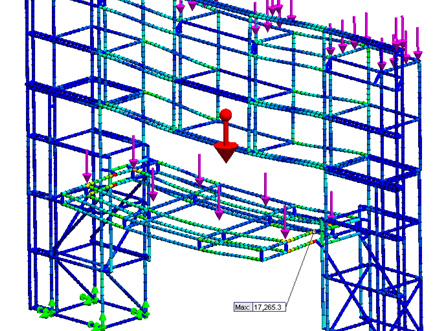Table of Contents
Table of Contents
Introduction
 In today’s fast-paced and competitive market, companies are constantly striving to bring new products to market quickly and efficiently. One powerful tool that can help accelerate the product development process is finite element analysis (FEA). FEA is a numerical method used to solve complex engineering problems by dividing a structure or system into smaller, more manageable elements. By analyzing the behavior of these elements under various conditions, engineers can gain valuable insights into the performance and durability of their products.
In today’s fast-paced and competitive market, companies are constantly striving to bring new products to market quickly and efficiently. One powerful tool that can help accelerate the product development process is finite element analysis (FEA). FEA is a numerical method used to solve complex engineering problems by dividing a structure or system into smaller, more manageable elements. By analyzing the behavior of these elements under various conditions, engineers can gain valuable insights into the performance and durability of their products.
This article aims to provide a comprehensive guide on how to accelerate product development with Finite Element Analysis. It will cover the basics of FEA, its benefits in the product development process, and various techniques and best practices to optimize the workflow. Real-world case studies will be presented to illustrate the practical applications of FEA in product development.
FEA offers several advantages that make it an invaluable tool for product development. Firstly, it allows engineers to simulate and analyze the behavior of a product under different operating conditions without the need for physical prototypes. This not only saves time and money but also enables engineers to identify potential design flaws and make necessary improvements early in the development cycle.
Furthermore, FEA provides a deeper understanding of the product’s performance, allowing engineers to optimize its design for maximum efficiency and reliability. By analyzing stress distribution, deformation, and other critical factors, engineers can make informed decisions to enhance the product’s performance and durability.
Overall, this article aims to equip readers with the knowledge and tools necessary to harness the power of FEA and accelerate their product development process. By leveraging FEA techniques and best practices, companies can gain a competitive edge by bringing high-quality products to market faster and more efficiently.
What is Finite Element Analysis (FEA)?
Finite Element Analysis (FEA) is a computational method used to analyze the behavior of complex structures and systems. It is a powerful tool that allows engineers and designers to simulate and predict the performance of products before they are physically built. FEA breaks down a complex structure into smaller, simpler elements, such as triangles for shell elements or tetrahedrals or bricks for solid elements, and analyzes the behavior of each element individually. By solving a set of mathematical equations, FEA calculates the stresses, strains, displacements, and other physical properties of the structure.
At Situs Engineering, we use FEA to assist various industries, including construction, automotive, civil engineering, and manufacturing, to name a few. It can be applied to a wide range of products, from simple components to large-scale structures. Some common applications of FEA include analyzing the strength and durability of mechanical components, optimizing the design of structures for weight reduction, and predicting the behavior of fluid flow and heat transfer.
One of the key advantages of FEA is its ability to provide detailed insights into the behavior of a product under different operating conditions. Engineers can simulate various scenarios, such as different loads, temperatures, and material properties, to understand how the product will perform in real-world conditions. This allows them to identify potential design flaws, optimize the product for better performance, and reduce the risk of failure.
FEA also offers significant time and cost savings in the product development process. By using FEA, engineers can quickly evaluate multiple design iterations and make informed decisions based on the simulation results. This eliminates the need for costly and time-consuming physical prototypes, as well as the associated testing and rework. Additionally, FEA enables engineers to identify and address potential issues early in the design phase, reducing the likelihood of costly design changes later on.
To summarize, Finite Element Analysis (FEA) is a powerful tool that can greatly accelerate the product development process. By simulating and analyzing the behavior of products before they are built, engineers can optimize their designs, reduce costs, and improve overall product performance. FEA is a valuable technique that should be incorporated into the product development workflow to unlock its full potential.
Benefits of Using FEA in Product Development
Finite Element Analysis (FEA) can significantly enhance the product development process. By simulating the behavior of a product under various conditions, FEA allows engineers to identify potential design flaws, optimize performance, and reduce the time and cost associated with physical prototyping.
One of the key benefits of using FEA in product development is the ability to gain insights into the structural integrity of a design. By subjecting a virtual model to different loads and forces, engineers can identify areas of high stress or potential failure. This information can then be used to make design modifications and ensure that the final product meets the required safety and performance standards.
FEA also enables engineers to optimize the performance of a product by analyzing its behavior under different operating conditions. For example, in the automotive industry, FEA can be used to simulate the impact of different road conditions on the suspension system, allowing engineers to fine-tune the design for maximum comfort and stability.
Another advantage of using FEA is the ability to reduce the number of physical prototypes required during the development process. By accurately predicting the behavior of a design, engineers can eliminate the need for costly and time-consuming trial-and-error iterations. This not only saves time and money but also allows for faster time-to-market.
Furthermore, FEA allows for the exploration of design alternatives without the need for physical prototypes. Engineers can quickly evaluate different materials, geometries, and manufacturing processes to identify the most optimal solution. This flexibility and agility in the design process can lead to innovative and cost-effective product solutions.
In addition to these benefits, FEA also provides a platform for collaboration and communication among different stakeholders involved in the product development process. By visualizing and analyzing the results of FEA simulations, engineers can effectively communicate design decisions and trade-offs to management, customers, and other team members.
The use of Finite Element Analysis (FEA) in product development offers numerous benefits. From improving structural integrity and optimizing performance to reducing the number of physical prototypes and enabling design exploration, FEA can significantly accelerate the product development process. By harnessing the power of FEA, engineers can unlock new possibilities and drive innovation in their respective industries.
Techniques to Accelerate Product Development with Finite Element Analysis
 Finite Element Analysis (FEA) is a powerful tool that can significantly speed up the product development process. By simulating the behavior of a product under various conditions, FEA allows engineers to identify potential issues and make necessary design modifications before physical prototypes are built. This not only saves time but also reduces costs associated with rework and testing.
Finite Element Analysis (FEA) is a powerful tool that can significantly speed up the product development process. By simulating the behavior of a product under various conditions, FEA allows engineers to identify potential issues and make necessary design modifications before physical prototypes are built. This not only saves time but also reduces costs associated with rework and testing.
Here are some techniques that can help accelerate product development using FEA:
- Early Integration of FEA: To maximize the benefits of FEA, it is important to integrate it into the product development workflow from the early stages. By starting FEA analysis early, engineers can identify design flaws and make necessary changes before moving forward. This helps avoid costly redesigns later in the process.
- Simplify the Model: FEA models can be complex and time-consuming to analyze. To speed up the analysis, it is important to simplify the model by removing unnecessary details and focusing on the critical aspects of the design. This reduces the computational time required for analysis and allows for faster iterations.
- Design Optimization: FEA can be used to optimize the design of a product by iteratively modifying parameters and evaluating their impact on performance. By using optimization algorithms, engineers can quickly identify the optimal design configuration that meets the desired criteria. This helps accelerate the product development process by reducing the number of physical prototypes required.
By implementing these techniques, engineers can accelerate product development with Finite Element Analysis. However, it is important to note that FEA is a complex tool that requires expertise and experience to yield accurate results. Therefore, it is recommended to invest in training and resources to ensure proper utilization of FEA in the product development workflow. Situs Engineering can provide custom SolidWorks FEA training to companies. Alternatively, Situs Engineering can conduct the FEA for companies that do not have the resources (i.e., software, technical experience, and available manpower) to do it themselves.
Best Practices for Optimizing Product Development Cycle with FEA
In order to optimize the product development cycle using finite element analysis (FEA), several best practices can be followed. These practices can help streamline the process, improve efficiency, and ensure accurate results.
- Define clear objectives: Before starting any FEA analysis, it is important to clearly define the objectives of the analysis. This includes identifying the specific problem or challenge that needs to be addressed, as well as the desired outcome. By having a clear understanding of the objectives, the FEA analysis can be focused and targeted toward achieving those goals.
- Use simplified models: In some cases, using simplified models can help speed up the FEA analysis process. By reducing the complexity of the model, the analysis can be completed more quickly, allowing for faster iterations and design improvements. However, it is important to ensure that the simplified model still accurately represents the behavior of the product under consideration.
- Validate and verify: It is crucial to validate and verify the FEA results against real-world data or physical testing. This helps ensure the accuracy and reliability of the analysis. By comparing the FEA results with experimental data, any discrepancies or errors can be identified and corrected, leading to more accurate predictions and better-informed design decisions.
- Collaborate and communicate: Effective collaboration and communication between different teams and stakeholders involved in the product development process is essential. This includes engineers, designers, analysts, and decision-makers. By sharing information, insights, and feedback, the FEA analysis can be integrated seamlessly into the overall product development workflow, leading to faster and more efficient decision-making.
- Continuous improvement: The product development cycle should be viewed as an iterative process, with continuous improvement at its core. This means that the FEA analysis should be used not only to solve immediate design challenges but also to gather insights and learnings that can be applied to future projects. By continuously refining and optimizing the FEA analysis techniques and workflows, the product development cycle can be further accelerated and improved.
By following these best practices, companies can harness the power of FEA to optimize their product development cycle and accelerate the time-to-market for their products. FEA can provide valuable insights and predictions, allowing for better-informed design decisions and improved product performance. With the right techniques and practices in place, FEA can be a powerful tool for driving innovation and efficiency in product development.
Case Studies: Real-world Examples of FEA in Product Development
In this section, we will explore real-world case studies that demonstrate the effectiveness of finite element analysis (FEA) in accelerating product development. These case studies will provide concrete examples of how FEA techniques have been successfully applied by Situs Engineering to optimize product designs and streamline the development process.
Case Study 1: Automotive Industry
One example of FEA in the automotive industry involves the redesign of a bracket that had previously experienced fatigue failures. By using FEA, we were able to simulate various load conditions and road vibrations to analyze the structural integrity of the chassis. This allowed us to identify potential weak points and make design modifications to improve the overall strength and performance of the bracket. As a result, the development time was significantly reduced, and the final product met all safety and performance requirements.
Case Study 2: Oil and Gas Industry
In the oil and gas industry, FEA has been instrumental in the development of required components. For instance, Situs Engineering uses FEA to analyze the stress distribution in tank nozzles to ensure they meet design load requirements. By simulating various load conditions, we can identify potential failure points and make design improvements to ensure the structural integrity of the nozzle. This not only accelerates the development process but ensures design requirements are achieved.
Case Study 3: Consumer Electronics Industry
 FEA has also been widely used in the consumer electronics industry to improve product performance and reliability. For example, in the development of a high-illumination LED fixture, FEA was used to analyze the thermal behavior of the device and optimize its cooling system. By simulating heat dissipation and airflow, Situs Engineering was able to identify potential overheating issues and make design modifications to enhance the device’s performance and prevent thermal damage. This case study demonstrates how FEA can be applied to address specific challenges in product development and ensure the quality and reliability of consumer electronics.
FEA has also been widely used in the consumer electronics industry to improve product performance and reliability. For example, in the development of a high-illumination LED fixture, FEA was used to analyze the thermal behavior of the device and optimize its cooling system. By simulating heat dissipation and airflow, Situs Engineering was able to identify potential overheating issues and make design modifications to enhance the device’s performance and prevent thermal damage. This case study demonstrates how FEA can be applied to address specific challenges in product development and ensure the quality and reliability of consumer electronics.
These case studies highlight the practical applications of FEA in various industries and showcase the tangible benefits of incorporating FEA into the product development workflow. By leveraging FEA techniques, companies can accelerate the development process, improve product performance, and reduce costs associated with physical prototyping and testing.
Common Challenges and Solutions in Implementing FEA for Product Development
Implementing finite element analysis (FEA) in product development can bring numerous benefits, but it also comes with its own set of challenges. Understanding and addressing these challenges is crucial to successfully integrating FEA into the product development workflow. In this section, we will explore some common challenges and provide solutions to overcome them.
One of the main challenges in implementing FEA is the complexity of the software and tools involved. FEA software can be highly technical and require specialized knowledge to operate effectively. Additionally, the large amount of data generated by FEA simulations can be overwhelming to manage and analyze. To overcome these challenges, it is important to invest in training and resources to ensure that the team has the necessary skills to use the software effectively. This can include providing training sessions, workshops, or even hiring experts in FEA to guide the team.
Another challenge is the integration of FEA into the existing product development workflow. FEA is a powerful tool, but it needs to be seamlessly integrated with other design and analysis tools to maximize its potential. This requires careful planning and coordination between different teams and departments involved in the product development process. It may be necessary to establish clear communication channels and workflows to ensure that FEA results are effectively incorporated into the design iterations.
The accuracy and reliability of FEA results can also be a challenge. FEA simulations are based on assumptions and simplifications, and the accuracy of the results depends on the quality of the input data and the assumptions made. It is important to validate and verify the FEA results through physical testing and comparison with real-world data. This can help identify any discrepancies and improve the accuracy of the simulations.
Lastly, cost can be a significant challenge in implementing FEA. The software and hardware required for FEA can be expensive, and the training and resources needed to use it effectively can also add to the cost. However, the long-term benefits of using FEA, such as reduced development time and improved product performance, often outweigh the initial investment. It is important to carefully evaluate the return on investment and consider the potential cost savings and improvements in product quality that FEA can bring.
Due to these challenges, many companies find it more effective to outsource their FEA needs to experienced FEA firms with proven track records of delivering reliable results.
Tools and Software for FEA in Product Development
In this section, we will explore the various tools and software available for finite element analysis (FEA) in product development. These tools play a crucial role in accelerating the product development process by providing engineers with the necessary capabilities to analyze and optimize their designs.
 While there are many FEA software packages, SolidWorks Simulation, Abaqus, and ANSYS are three of the most prominent software solutions widely used for finite element analysis (FEA) and computer-aided engineering (CAE) simulations in industry, so this article focuses on these three tools. Each of these FEA software offers unique features and capabilities, making them suitable for different engineering applications. Below, we will compare these three software packages in terms of their usability, capabilities, and industry relevance.
While there are many FEA software packages, SolidWorks Simulation, Abaqus, and ANSYS are three of the most prominent software solutions widely used for finite element analysis (FEA) and computer-aided engineering (CAE) simulations in industry, so this article focuses on these three tools. Each of these FEA software offers unique features and capabilities, making them suitable for different engineering applications. Below, we will compare these three software packages in terms of their usability, capabilities, and industry relevance.
Abaqus offers a robust simulation environment that is a powerful tool for complex simulations, including nonlinear material behavior and multiphysics analysis, making it suitable for advanced engineering tasks. It excels in simulating complex material behaviors, large deformations, and contact interactions. Abaqus is prevalent in the aerospace industry, where complex material behaviors and interactions are vital.
ANSYS provides a wide range of simulation capabilities, from structural analysis to fluid dynamics and electromagnetic simulations. ANSYS is often used by researchers at universities and in industries requiring advanced simulations and multiphysics capabilities.
SolidWorks Simulation is known for its seamless integration with SolidWorks CAD software. This integration allows for easy transfer of CAD models to the simulation environment. It’s a great choice for designers and engineers who want a FEA tool closely linked to their CAD work. SolidWorks Simulation primarily focuses on structural analysis, thermal analysis, and fluid dynamics. It is ideal for mechanical and product design applications, such as assessing the strength and performance of components and assemblies. SolidWorks Simulation is widely used in the mechanical and product design industries, where quick and accurate simulations are essential for optimizing designs.
SolidWorks Simulation’s shortcoming comes in its ability to solve very high-strain problems (e.g., the crushing of an aluminum can) that can be solved by ANSYS and Abaqus. However, the majority of FEA problems do not involve these high-strain situations. So, despite this limitation, Situs Engineering chooses to use SolidWorks Simulation to solve the vast majority of its FEA challenges as its seamless integration into the SolidWorks CAD software typically provides for very proficient and more economical outcomes.
The final choice between SolidWorks Simulation, Abaqus, and ANSYS depends on your specific engineering needs. SolidWorks Simulation is suited for design-centric tasks with seamless integration to CAD, while Abaqus and ANSYS offer advanced capabilities catering to complex simulations.
Conclusion: Unlocking the Potential of FEA for Accelerated Product Development
In conclusion, finite element analysis (FEA) is a powerful tool that can significantly accelerate the product development process. By harnessing the capabilities of FEA techniques, companies can optimize their designs and achieve maximum efficiency in their product development cycle.
FEA offers numerous benefits for product development. It allows engineers to simulate and analyze the behavior of their designs under various conditions, enabling them to identify potential issues and make necessary improvements early in the development process. This not only saves time but also reduces the risk of costly errors and rework later on.
To optimize the product development cycle with FEA, it is important to follow best practices. This includes properly defining the simulation objectives, selecting appropriate boundary conditions, and validating the results against experimental data. By following these best practices, engineers can ensure the accuracy and reliability of their simulations, leading to more informed design decisions.
Real-world case studies provide valuable insights into the practical applications of FEA in product development. By examining these examples, engineers can gain a better understanding of how FEA can be effectively utilized to solve complex engineering problems and accelerate the development of innovative products.
Implementing FEA for product development may come with its own set of challenges. However, with the right training or by selecting the right FEA service provider, these challenges can be overcome so that any company can accelerate Product Development with Finite Element Analysis
In conclusion, by unlocking the potential of FEA, companies can supercharge their product development process. By incorporating FEA techniques and best practices, engineers can optimize their workflow, accelerate design iterations, and ultimately bring high-quality products to market faster.

